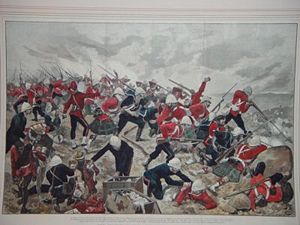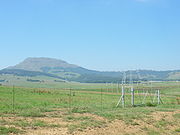- Battle of Majuba Hill
-
Battle of Majuba Part of First Boer War 
The Battle of Majuba, drawn by Richard Caton Woodville for the Illustrated London NewsDate 27 February 1881 Location Majuba Hill, near Volksrust,
Kwazulu-Natal, South Africa
27°27′42″S 29°51′41″E / 27.4616°S 29.8613°ECoordinates: 27°27′42″S 29°51′41″E / 27.4616°S 29.8613°EResult Decisive Boer victory Belligerents  South African Republic
South African Republic United Kingdom
United KingdomCommanders and leaders  Stephanus Roos
Stephanus Roos
 Danie Malan
Danie Malan
 Joachim Ferreira
Joachim Ferreira Major-General Sir George Pomeroy Colley †
Major-General Sir George Pomeroy Colley †Strength 400-500 men 405 infantry Casualties and losses 1 dead
5 wounded92 dead
134 wounded
59 capturedThe Battle of Majuba Hill (near Volksrust, South Africa) on 27 February 1881 was the main battle of the First Boer War. It was a resounding victory for the Boers. Major-General Sir George Pomeroy Colley occupied the summit of the hill on the night of February 26–27, 1881. His motive for occupying the hill remains unclear. The Boers believed that he may have been attempting to outflank their positions at Laing's Nek.
The bulk of the 405 British soldiers occupying the hill were 171 men of the 58th Regiment with 141 men of the 92nd (Gordon) Highlanders, and a small naval brigade from HMS Dido. General Colley had brought no artillery up to the summit, nor did he order his men to dig in, expecting that the Boers would retreat when they saw their position on the Nek was untenable. However, the Boers quickly formed a group of storming parties, led by Nicolas Smit, from an assortment of volunteers from various commandos, totaling at least 450 men, maybe more, to attack the hill.
By daybreak at 4:30, the 92nd Highlanders covered a wide perimeter of the summit, while a handful occupied Gordon's Knoll on the right side of the summit. Oblivious to the presence of the British troops until the 92nd (Gordon) Highlanders began to yell and shake their fists, the Boers began to panic fearing an artillery attack.[1] Three Boer storming groups of 100-200 men each began a slow advance up the hill. The groups were led by Field Cornet Stephanus Roos, Commandant D.J.K. Malan and Commandant Joachim Ferreira. The Boers, being the better marksmen, kept their enemy on the slopes at bay while groups crossed the open ground to attack Gordon's Knoll, where at 12:45 Ferreira's men opened up a tremendous fire on the exposed knoll and captured it.
Over the next hour, the Boers poured over the top of the British line and engaged the enemy at long range, refusing hand-to-hand combat action and picking off the British one by one. The Boers were able to take advantage of the scrub and long grass which covered the hill, something that the British were not trained to do. It was at this stage that British discipline began to wane and panicky troops began to desert their posts, unable to see their opponents and being given very little in the way of direction from officers. When more Boers were seen encircling the mountain, the British line collapsed and many fled pell-mell from the hill. The Boers were able to launch an attack which shattered the already crumbling British line.
Amidst great confusion and with casualties amongst his men rising, Colley attempted to order a fighting retreat, but was shot by Boer marksmen. The rest of the British force fled down the rear slopes of Majuba, where more were hit by the Boer marksmen, who had lined the summit in order to shoot at the retreating foe. An abortive rearguard action was staged by the 15th The King's Hussars and 60th rifles, who had marched from mount prospect, although this made little impact on the Boer forces. Two hundred and eighty Britons were killed, captured or wounded.
Although small in scope, the battle is historically significant for three reasons:
- It led to the signing of a peace treaty and later the Pretoria Convention, between the British and the newly created South African Republic, ending the First Boer War.
- The fire and movement ("vuur en beweeg" in Afrikaans) tactics employed by the Boers, especially Commandant Smit in his final assault on the hill, were years ahead of their time.
- Coupled with the defeats at Laing's Nek and Schuinshoogte, this third crushing defeat at the hands of the Boers ratified the strength of the Boers in the minds of the British, arguably to have consequences in the Second Anglo-Boer War. "Remember Majuba" became a rallying cry.
Majuba Hill seen from Laing's Nek; buildings on the right include the museum.Notes
- ^ Martin Meredith, Diamonds Gold and War, (New York: Public Affairs, 2007):162
References
- Martin Meredith, Diamonds Gold and War, (New York: Public Affairs, 2007):162
- The South African Military History Society Journal vol 5 no 2. Details the battle.
- Jan Morris, Heaven's Command, Faber and Faber, London, 1998, pp 442–445.
Further reading
- Castle, Ian (1996). Majuba 1881: The Hill of Destiny. Osprey Campaign Series. #45. Osprey Publishing. ISBN 1-85532-503-9.
External links
- Majuba Day Celebration. The Right Perspective interviews Dr. Lets Pretorius, Maj. Henry Pinkham (ret.) of the SADF, Gerhard Combrinck, and 92-year old Oom Harhetz van Blerk, about Majuba Day, the day commemorating the battle.
Categories:- Conflicts in 1881
- Battles of the First Boer War
- 1881 in South Africa
- History of KwaZulu-Natal
- History of South Africa
Wikimedia Foundation. 2010.


